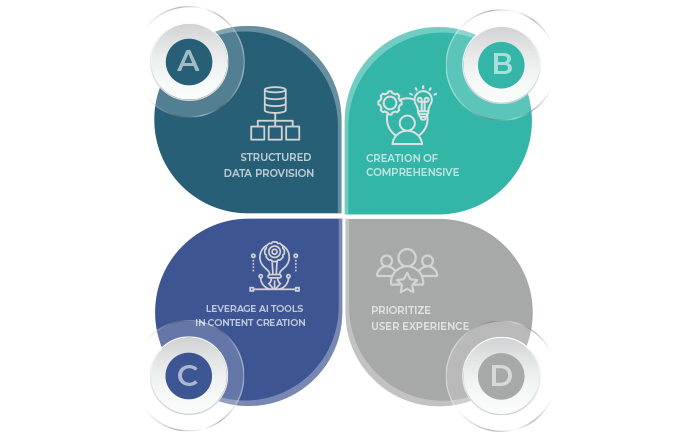
Google shocked the SEO community in late 2023 by revealing their new Search Generative Experience (SGE), which makes use of cutting-edge AI models. SGE removes the need for consumers to click on particular search results by providing them with automatically generated responses, summaries, and recommendations for their search queries.
For SEOs who have devoted years to optimize websites for higher rankings in Google’s customary ten blue links, this development presents a serious problem. The significance of organic traffic from high ranks decreases when SGE offers clear solutions.
There are still opportunities, though. This is a how-to tutorial for 2024 optimization for Google’s new SGE algorithm.
For ranking systems to be effective, it is essential to comprehend how SGE functions. Google uses SGE to search the web for up-to-date content and create new text, lists, and multimedia using large language models.
These days, getting high ranks depends on producing information that helps Google’s AI understand subjects and entities in order to produce insightful search results. Optimization for AI support replaces optimization for organic traffic.
Structured Data Provision
Provision of extensive structured data is essential. This includes entity relationships, knowledge graphs, and schema markup. The more structured data your content has on a range of subjects, the better SGE will be able to identify key components that should be included into search experiences.
Use JSON-LD, schema.org markup, and other techniques to guarantee clean structured data. Make sure you keep up your own knowledge graphs, especially for complex or industry-specific topics where the generic Google graph may be deficient. Make an attempt to use mentions and reputable links to connect related entities inside your content.
Creation of Comprehensive, Long-Form Content
SGE appreciates thorough, reliable content. The more you learn about a subject, the better. Consider writing thorough instructions that are 10,000 words long and cover every aspect. When appropriate, incorporate a variety of media, including text, pictures, videos, tables, and charts.
Give priority to visual materials such as presentations, graphics, and YouTube videos. SGE is intended to highlight images in addition to text in search results.
Incorporate Variety in Inputs
The training of large language models, which underpin SGE, requires that they be exposed to a variety of inputs, including both textual and visual media spanning a wide range of subtopics. Reflecting this diversity in your material can make it more useful.
Use appropriate quotes, examples, professional opinions, open references, original sources, and significant studies/statistics sparingly in long-form writings. Avoid boredom by avoiding walls of text and instead enhance written explanations using pictures, infographics, and videos throughout.
Reference Authoritative External Sources
In keeping with the objective of embracing a variety of inputs, constantly include links and citations to reliable outside sources. Similar to SGE, Google gives websites that connect to other reliable sites on related topics a high level of credibility.
Instead of depending only on internal content, you may show the value you offer by carefully selecting and citing high-quality external content from reliable sources. When referencing outside sources, briefly summarize the most important elements that either support or contradict the ideas being discussed.

Craft Content for Clarity and Comprehension
SGE rewards clarity and ease of understanding, two qualities that large language models excel at. Make your material as readable and AI-friendly as possible. This means:
Optimize Readability for AI Consumption
- Simple and Direct Communication: Write clear, concise paragraphs and sentences that each concentrate on a single idea.
- Effective Formatting: To improve readability, use headings and formatting that are appropriate.
- Highlight Key Terms: To improve understanding, highlight important terms with bold and provide precise definitions.
- Simplify Complex Concepts: Before getting into in-depth explanations, give a concise summary of complicated subjects.
- Use Lists for Key Points: Rather than using long, dense paragraphs to highlight important points, use concise, numbered lists.
- Table of Contents: To improve accessibility and navigation, include a table of contents for longer posts.
Leverage AI Tools in Content Creation
- AI-Powered Research: When writing, use AI semantic search to look up and recommend relevant ideas.
- Predictive Writing Assistance: To expedite the drafting process, make use of the predictive writing tools found in programs such as Google Docs.
- Grammar and Style Checking: To find and fix errors, use artificial intelligence grammar checkers like Grammarly.
- Enhanced Rewriting: Try out AI-driven rewriting recommendations from programs like Quillbot to hone and enhance paragraph readability.
Content that is easily understood by SGE is produced more effectively when human ingenuity is combined with computer-assisted writing and editing. Allow computers to assist in the creation of content that ranks well in Google’s machine-generated search results!
Prioritize User Experience
While SGE changes SEO, user experience (UX) continues to be the most important factor. Providing the greatest search experience is something Google still emphasizes. Thus, site speed should be maximized for quick loading, page layout should be friendly, and copy should include strong calls-to-action.
It’s critical to preserve an easy-to-use information architecture (IA), smooth site navigation, eye-catching but discrete visual elements, and a satisfying user experience overall. Don’t overoptimize your website just to please Google’s classifiers at the price of user experience. Achieve a delicate equilibrium between user requirements and SEO for SGE.
Focus on Key Aspects First
Acquiring proficiency in every SGE optimization technique at the same time might be daunting. Rather, focus first on being proficient in these essential, high-impact areas:
You can outperform rivals that are still catching up with SGE SEO requirements if you just use these five strategies:
- Maximize Schema Markup: To improve visibility, add a lot of schema markup to every page that is available.
- Foster Interconnectedness: To improve the browsing experience, constantly create linkages and mentions between similar information.
- Craft Comprehensive Guides: To establish authority, create long-form, authoritative guides on pertinent topics that are more than 10,000 words in length.
- Enrich Content with Multimedia: To improve understanding and interaction, liberally use graphs, charts, and pictures into posts.
- Reference Quality Sources: To increase credibility and provide value, mention reliable outside sources frequently.
Via Google’s new Search Generative Experience, content ranking requires a shift from classic organic SEO techniques. Brands can differentiate themselves using SGE by optimizing for machine comprehension, input diversity, external sourcing, length, and media formats.
Websites that make a substantial contribution to helping Google’s AI comprehend subjects and improve search experiences will have their material heavily highlighted. Make use of these 2024 SGE SEO pointers to obtain a competitive advantage while using AI to interact with search audiences.
Concentrate on producing information that is machine-readable and let Google handle how it presents it to consumers based on their individual queries. AI will play a major role in search engine optimization in the future!


